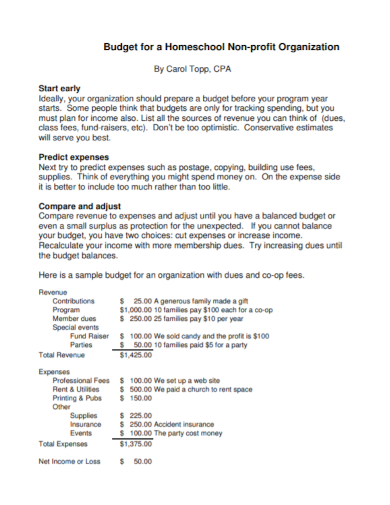A non-profit organization, or also called a non-profit institution, is an entity that is organized for the benefit of the betterment of the society or environment. Managing a non-profit organization is not easy especially planning the budget to allocate limited resources within the organization. If your organization doesn’t have a budget plan, you better start right now. Read the article below on how to make a budget for a non-profit organization.
3+ Non-Profit Organization Budget Samples
1. Homeschool Non-profit Organization Budget
2. Non-Profit Services Organization Budget
3. Non-Profit Organization Annual Operating Budget
4. Non-Profit Organization Budget Worksheet
Importance of Making a Budget for Your Non-Profit Organization
Even if your non-profit organization is staffed entirely by volunteers, your group will need to create a budget to accomplish its goals. Your budget should be the basis for these three activities:
A non-profit organization needs to budget their finances especially that they only have limited resources and must only be spent on the most important activities. These activities are: raising money for the organization to continue their work, reporting to the board of chairman, and doing the work for your community. The budget can be a basis for planning for the operations of the organization and the goals they want to accomplish.
How to Make a Non-Profit Organization Budget
Designate A Person Responsible for the Budget
It’s important to assign a person (or if your organization is bigger, you can assign a team) who will be in charge of handling the organization’s budget. The person will be responsible to create a draft budget for the organization.
Make a list of the Revenue You Acquired
List also the origin of the revenue you acquired and categorize them. For example, list the amount you acquired from membership fees, or from donations, or from fundraising events.
Base Your Budget on Your Organization’s Operational Structure
The budget officer, as what the person in charge of it should be called, must create a budget that will first: take care of fixed costs, the costs that your organizations steadily spend money on like rent, utilities, equipment, salaries (or allowances), and usual programs or activities you do daily or weekly. These fixed costs are the core essentials to make the organization’s regular operations continue without a hitch so make sure to take care of it first before anything else.
After calculating your fixed expenses, it’s time to consider other expenses that don’t necessarily you’ll spend every day but occasionally. These expenses include fundraising activities and events costs, marketing and promotion costs. These activities are much more complicated to budget since these are major activities in which the budget vary since its expenses depend on the logistics of the event and these also need separate planning in order for these to push through successfully.
The next phase of the budget planning is other expenses that include insurance, accounting, and auditing, implementing projects, equipment, and facility maintenance. And lastly, if your budget still allows it, set aside some money just in case you need an extra to cover some expenses that exceeded their own budget. This will prevent you from getting short and worrying about where to get extra money just to pay for those extra expenses.
FAQs
What are the four types of budget?
There are four main types of budgeting methods used by a lot of organizations. There are incremental (taking the previous year’s and add a percentage of it to determine the current year’s budget), activity-based (budgeting is determined on the amount needed to support the outputs and target goals of the organization), value proposition (making sure that all the parts of the organization that is being budgeted will result on the advancement of the organization), and zero-based (assuming that all the department’s budget is zero and budgeting must start from scratch).
How does a non-profit organization make money?
Funds from non-profit organizations came from various sources some examples are membership dues, philanthropic foundations, grants from government agencies, and private donations.
What are the benefits of starting a non-profit organization?
There are benefits to having a non-profit organization. It gives you the privilege to be exempted from paying taxes, you’ll have access to government grants, discounts from US Postal Service, your organization can exist as long as it wants to, and your employees will be protected against liabilities from the organization.
One thing to remember after making your budget is to be open and transparent to everyone in the organization. Communicate to them how the budget is broken down to different expenses for the operations of the organization. Although it’s true that creating a budget can be a challenge, it doesn’t have to be difficult at all times. To help you get started, you can refer to the sample budget spreadsheets templates provided above to help you keep track of your estimations. These spreadsheets are free and very easy to download so you can go ahead now and download one for you to use!
Related Posts
FREE 10+ Budget Report Samples in PDF MS Word | Excel
FREE 10+ Monitoring a Budget Samples in PDF MS Word
FREE 10+ Budget Templates in MS Word Excel | PDF
FREE 11+ Sales Budget Samples in Google Docs Google Sheets ...
FREE 11+ Account Budget Samples in MS Word PDF
FREE 33+ Budget Forms in PDF MS Word | Excel
How to Create a Church Budget [13+ Samples]
FREE 9+ Sample Budget Reports in PDF MS Word | Excel | Google ...
FREE 12+ Family Budget Samples in Google Docs Google Sheets ...
FREE 11+ Sample Budget Request Forms in MS Word PDF | Excel
FREE 12+ Event Budget Proposal Templates in PDF MS Word ...
FREE 11+ Travel Budget Templates in Google Docs Google ...
FREE 9+ Budget Memo Templates in MS Word PDF
FREE 10+ Sample Grant Budgets in PDF MS Word | Excel | Google ...
FREE 33+ Budget Templates in MS Word PDF | Excel




